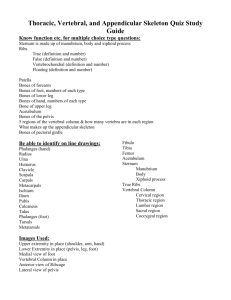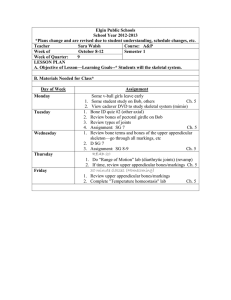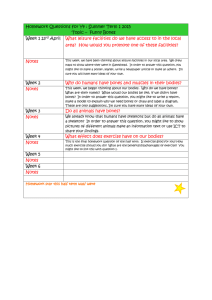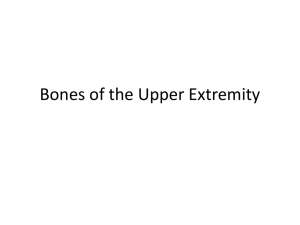Skeletal System Part 4
advertisement
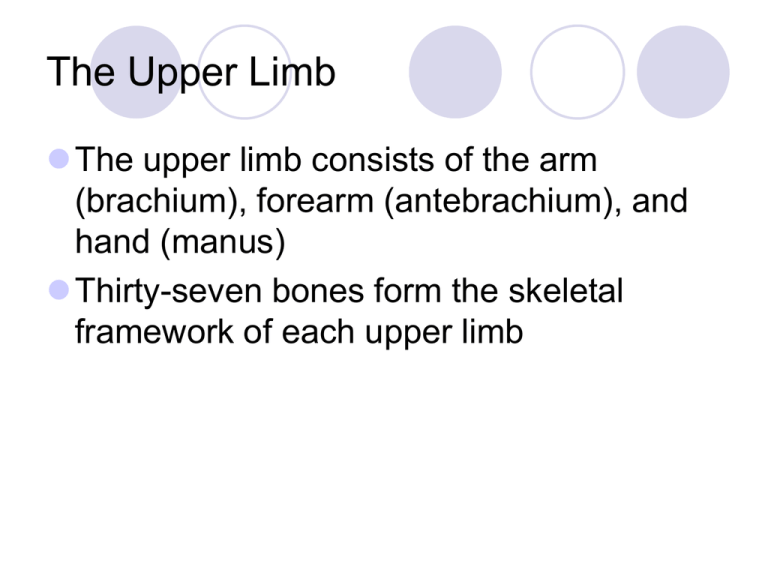
The Upper Limb The upper limb consists of the arm (brachium), forearm (antebrachium), and hand (manus) Thirty-seven bones form the skeletal framework of each upper limb Arm The humerus is the sole bone of the arm It articulates with the scapula at the shoulder, and the radius and ulna at the elbow Arm Major markings Proximal humerus includes the head, anatomical and surgical necks, greater and lesser tubercles, and the intertubercular groove Distal humerus includes the capitulum, trochlea, medial and lateral epicondyles, and the coronoid and olecranon fossae Medial portion includes the radial groove and the deltoid process Humerus of the Arm Figure 7.23 Forearm The bones of the forearm are the radius and ulna They articulate proximally with the humerus and distally with the wrist bones They also articulate with each other proximally and distally at small radioulnar joints Interosseous membrane connects the two bones along their entire length Bones of the Forearm Figure 7.24 Ulna The ulna lies medially in the forearm and is slightly longer than the radius Forms the major portion of the elbow joint with the humerus Its major markings include the olecranon, coronoid process, trochlear notch, radial notch, and the styloid process Radius The radius lies opposite (lateral to) the ulna and is thin at its proximal end, widened distally The superior surface of the head articulates with the capitulum of the humerus Medially, the head articulates with the radial notch of the ulna Major markings include the radial tuberosity, ulnar notch, and styloid process Radius and Ulna Figure 7.24 Hand Skeleton of the hand contains wrist bones (carpals), bones of the palm (metacarpals), and bones of the fingers (phalanges) Figure 7.26a Carpus (Wrist) Consists of eight bones Scaphoid, lunate, triquetral, and pisiform proximally Trapezium, trapezoid, capitate, and hamate distally Metacarpus (Palm) Five numbered (1-5) metacarpal bones radiate from the wrist to form the palm Their bases articulate with the carpals proximally, and with each other medially and laterally Heads articulate with the phalanges Phalanges (Fingers) Each hand contains 14 miniature long bones called phalanges Fingers (digits) are numbered 1-5, beginning with the thumb (pollex) Each finger (except the thumb) has three phalanges – distal, middle, and proximal The thumb has no middle phalanx Comparison of Male and Female Pelves Table 7.4.1 Comparison of Male and Female Pelves Table 7.4.2 Pelvic Girdle (Hip) The hip is formed by a pair of hip bones (os coxae, or coxal) Together with the sacrum and the coccyx, these bones form the bony pelvis Pelvic Girdle (Hip) The pelvis Attaches the lower limbs to the axial skeleton with the strongest ligaments of the body Transmits weight of the upper body to the lower limbs Supports the visceral organs of the pelvis Pelvic Girdle (Hip) Figure 7.27a Ilium The ilium is a large flaring bone that forms the superior region of the coxal bone It consists of a body and a superior winglike portion called the ala The broad posterolateral surface is called the gluteal surface Ilium The auricular surface articulates with the sacrum (sacroiliac joint) Major markings include the iliac crests, four spines, greater sciatic notch, iliac fossa, arcuate line, and the pelvic brim Ilium: Lateral View Figure 7.27b Ilium: Medial View Figure 7.27c Ischium The ischium forms the posteroinferior part of the hip bone The thick body articulates with the ilium, and the thinner ramus articulates with the pubis Major markings include the ischial spine, lesser sciatic notch, and the ischial tuberosity Pubis The pubic bone forms the anterior portion of the hip bone It articulates with the ischium and the ilium Major markings include superior and inferior rami, the pubic crest, pubic tubercle, pubic arch, pubic symphysis, and obturator foramen (along with ilium and ischium) Pubis: Lateral View Figure 7.27b Pubis: Medial View Figure 7.27c Comparison of Male and Female Pelvic Structure Female pelvis Tilted forward, adapted for childbearing True pelvis defines birth canal Cavity of the true pelvis is broad, shallow, and has greater capacity Comparison of Male and Female Pelvic Structure Male pelvis Tilted less forward Adapted for support of heavier male build and stronger muscles Cavity of true pelvis is narrow and deep Comparison of Male and Female Pelvic Structure Image from Table 7.4 Comparison of Male and Female Pelvic Structure Characteristic Female Male Bone thickness Lighter, thinner, and smoother Heavier, thicker, and more prominent markings Pubic arch/angle 80˚–90˚ 50˚–60˚ Acetabula Small; farther apart Large; closer together Sacrum Wider, shorter; sacral curvature is accentuated Narrow, longer; sacral promontory more ventral Coccyx More movable; straighter Less movable; curves ventrally The Lower Limb The three segments of the lower limb are the thigh, leg, and foot They carry the weight of the erect body, and are subjected to exceptional forces when one jumps or runs Femur The sole bone of the thigh is the femur, the largest and strongest bone in the body It articulates proximally with the hip and distally with the tibia and fibula Major markings include the head, fovea capitis, greater and lesser trochanters, gluteal tuberosity, lateral and medial condyles and epicondyles, linea aspera, patellar surface, and the intercondylar notch Femur Figure 7.28b Leg The tibia and fibula form the skeleton of the leg They are connected to each other by the interosseous membrane They articulate with the femur proximally and with the ankle bones distally They also articulate with each other via the immovable tibiofibular joints Tibia Receives the weight of the body from the femur and transmits it to the foot Major markings include medial and lateral condyles, intercondylar eminence, the tibial tuberosity, anterior crest, medial malleolus, and fibular notch Tibia and Fibula Figure 7.29 Fibula Sticklike bone with slightly expanded ends located laterally to the tibia Major markings include the head and lateral malleolus Foot The skeleton of the foot includes the tarsus, metatarsus, and the phalanges (toes) The foot supports body weight and acts as a lever to propel the body forward in walking and running Figure 7.31a Tarsus Composed of seven bones that form the posterior half of the foot Body weight is carried primarily on the talus and calcaneus Talus articulates with the tibia and fibula superiorly, and the calcaneus inferiorly Other tarsus bones include the cuboid and navicular, and the medial, intermediate, and lateral cuneiforms Tarsus Figure 7.31b, c Calcaneus Forms the heel of the foot Carries the talus on its superior surface Point of attachment for the calcaneal (Achilles) tendon of the calf muscles Metatarsus and Phalanges Metatarsals Five (1-5) long bones that articulate with the proximal phalanges The enlarged head of metatarsal 1 forms the “ball of the foot” Phalanges The 14 bones of the toes Each digit has three phalanges except the hallux, which has no middle phalanx Metatarsus and Phalanges Figure 7.31a Arches of the Foot The foot has three arches maintained by interlocking foot bones and strong ligaments Arches allow the foot to hold up weight The arches are: Lateral longitudinal – cuboid is keystone of this arch Medial longitudinal – talus is keystone of this arch Transverse – runs obliquely from one side of the foot to the other Arches of the Foot Figure 7.32 Developmental Aspects: Fetal Skull Infant skull has more bones than the adult skull At birth, fetal skull bones are incomplete and connected by fontanels Fontanels Unossified remnants of fibrous membranes between fetal skull bones The four fontanels are anterior, posterior, mastoid, and sphenoid Developmental Aspects: Fetal Skull Skull bones such as the mandible and maxilla are unfused Figure 7.33 Developmental Aspects: Growth Rates At birth, the cranium is huge relative to the face Mandible and maxilla are foreshortened but lengthen with age The arms and legs grow at a faster rate than the head and trunk, leading to adult proportions Figure 7.34 Developmental Aspects: Spinal Curvature Only thoracic and sacral curvatures are present at birth The primary curvatures are convex posteriorly, causing the infant spine to arch like a four-legged animal Secondary curvatures – cervical and lumbar – are convex anteriorly and are associated with the child’s development Developmental Aspects: Old Age Intervertebral discs become thin, less hydrated, and less elastic Risk of disc herniation increases Loss of stature by several centimeters is common after age 55 Costal cartilages ossify causing the thorax to become rigid All bones lose mass

